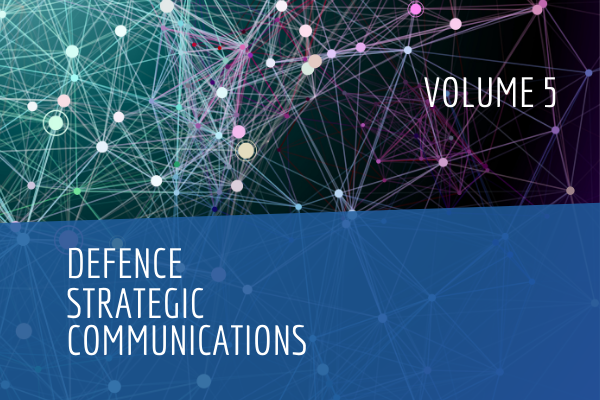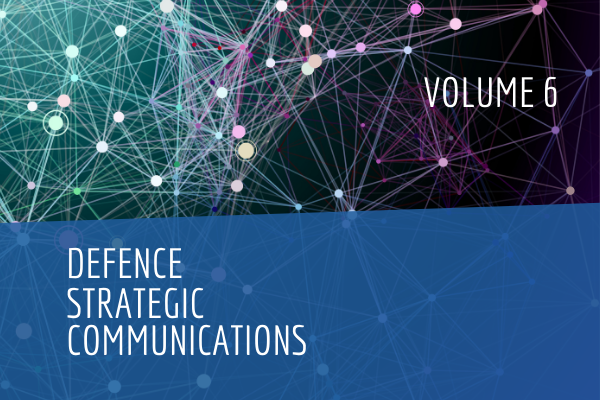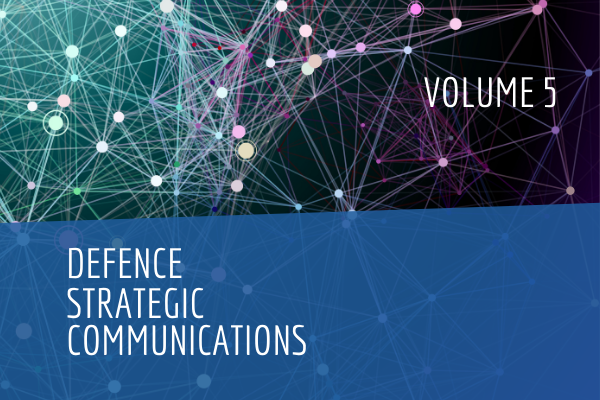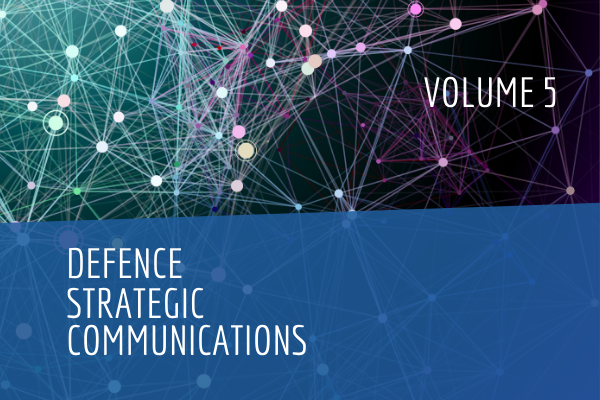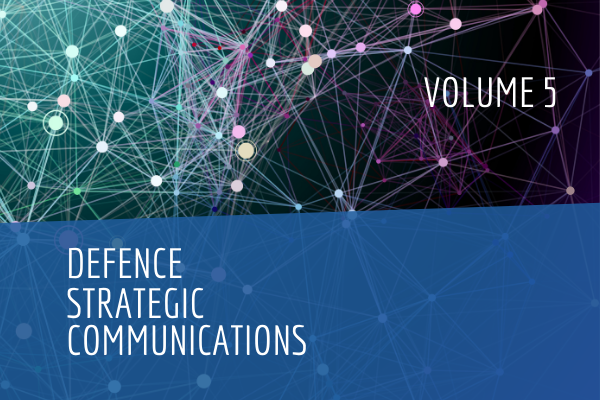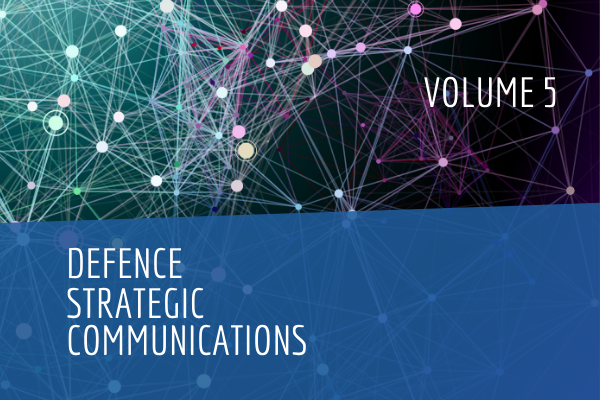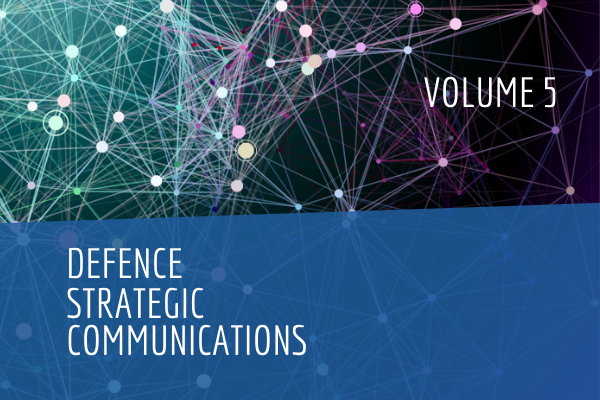Abstract
Governments using strategic communications to influence an audience should continue to reassess the intellectual grounds of the discipline. Current thinking on how best to construct a campaign and influence an audience is mixed, sparse, and incomplete. Insights from musicology present an opportunity for a refreshed perspective. Music, as a social text, a practice, and an ecology, provides a powerful means of communication from which lessons of influence can be learnt. This article serves as a study into the parallels between two interconnected topics. It proposes that insight from musicology has the ability to improve strategic communications practice on two levels—constructing a compelling narrative and best influencing an audience. Two case studies are compared to illustrate the benefits of persuading through emotionally-based strategic communications—a Daesh nasheed with music and a counter-narrative campaign without. This article highlights how communicating through a rational-actor model is outdated; to best affect the physiological and emotional state of the audience, musicology must be incorporated.
Keywords— musicology, strategic communications, emotion, rational-actor, influence
Bibliography
Abdullah-X, ‘Five Considerations for a Muslim on Syria’, YouTube, 7 March 2014.
_____, ‘A Message to Muslim Youth’, YouTube, 27 Oct 2015.
_____,‘Knowing Your Place’, YouTube, 12 Oct 2016.
_____,‘Abdullah-X: Freedom of Speech vs Responsibility #CharlieHebdo’, 13 Jan 2015.
_____,‘Abdullah-X’, Accessed 10 July 2018.
Anderson, C. A., N. I. Carnagey and J. Eubanks, ‘Exposure to Violent Media: The effects of songs with violent lyrics on aggressive thoughts and feelings’, Journal of Personality and Social Psychology, 84 (2003): 960–71.
Archetti, Cristina, Understanding Terrorism in the Age of Global Media: A Communication Approach (New York: Palgrave Macmillan, 2013).
Ball, Philip, The Music Instinct: How Music Works and Why We Can’t Do Without It (New York: Oxford University Press, 2011).
Barthes, Roland, Image, Music, Text (London: Fontana Press, 1977).
Bolt, Neville, The Violent Image (London: C. Hurst & Co, 2012).
Bolt, Neville, ‘Strategic Communications in Crisis’, RUSI Journal, Vol. 156, № 4, (2011): 44–53.
Boudon, Raymond, ‘Beyond Rational Choice Theory’, Annual Review of Sociology, 29 (2003): 1–21.
Boudreau, Brett, We Have Met the Enemy and He Is Us (NATO Strategic Communications Centre of Excellence, 2016), p. 276.
Briggs, Rachel and Sebastian Feve, ‘Review of Programs to Counter Narratives of Violent Extremism: What works and what are the implications for government?’ (Institute for Strategic Dialogue, 2013).
Bruner, J., ‘The Narrative Construction of Reality’, Critical Inquiry, 18, (1991):
1–21.
Capra, Fritjof and Pier Luigi Luisi, The Systems View of Life (Cambridge: Cambridge University Press, 2016).
Capra, Fritjof, The Hidden Connections (United Kingdom: Harper Collins, 2002).
Castells, Manuel, Communications Power (Oxford: Oxford University Press, 2013).
Castells, Manuel, The Rise of The Network Society (Wiley, 2000).
Castells, Manuel, The Network Society: A Cross-cultural Perspective (Northampton, MA: Edward Elgar, 2004).
Clayton, M., R. Sager and U. Will, ‘In Time with the Music: The Concept of Entrainment and its Significance for Ethnomusicology’, European Meetings in Ethnomusicology, 11 (2005): 3–75.
Cornish, Paul, Julian Lindley-French and Claire Yorke, ‘Strategic Communications and the National Strategy’ A Chatham House Report. The Royal Institute of International Affairs (2011): 1–45.
Ćosić, Krešimir, Armano Srbljinović and Siniša Popović, ‘Emotionally Based Strategic Communications in the Process of Societal Deradicalization’, International Journal of Strategic Communication, 12 (2018): 196–214.
Dalgaard-Nielsen, Anja, ‘Promoting Exit from Violent Extremism: Themes and Approaches’, Studies in Conflict & Terrorism, 36 (2013): 99–115.
Davies, J.B., The Psychology of Music (London: Hutchinson, 1978).
De Graaf, Beatrice, George Dimitriu and Jen Ringsmose (eds.), Strategic Narratives, Public Opinion and War: Winning Domestic Support for the Afghan War (New York, NY: Routledge, 2015).
Demos, A.P., R. Chaffin, K.T. Begosh, J.R. Daniels and K.L. Marsh, ‘Rocking to the Beat: Effects of Music and Partners’ Movements on Spontaneous Interpersonal Coordination’, Journal of Experimental Psychology: General, 141 (2012): 49–53.
DeNora, T., Music in Everyday Life (Cambridge: Cambridge University Press, 2000).
Eyerman, R. and A. Jamison, Music and Social Movements: Mobilizing Traditions in the Twentieth Century (New York: Cambridge University Press, 1998).
Farwell, James, Persuasion and Power (Georgetown: University Press, 2013).
Fernández-Sotos, A., A. Fernández-Caballero and J. M. Latorre, ‘Influence of Tempo and Rhythmic Unit in Musical Emotion Regulation’, Frontiers in Computational Neuroscience, 10 (2016).
Frith, S., ‘Music and everyday life’, Critical Quarterly, 44 (1), (2002): 35-48.
Garofalo, R., Rockin’ the Boat (Cambridge, MA: Beacon Press, 1992).
Gerges, Fawaz, Journey of the Jihadist (Florida: Harcourt, 2008).
Giddens, A., Modernity and Self-Identity: Self and Society in the Late Modern Age (Cambridge: Polity Press, 1991).
Giroux, Henry A., ‘Totalitarian Paranoia in the Post-Orwellian Surveillance State’, Cultural Studies, 29 (2015): 108–40.
Gråtrud, Henrik, ‘Islamic State Nasheeds As Messaging Tools’, Studies in Conflict & Terrorism, 39:12 (2016): 1050–70.
Hanska, Jan, ‘From Narrated Strategy to Strategic Narratives’, Critical Studies on Security, 3:3, (2015): 323–25.
Hemmingsen, A.S. and K. I. Castro, ‘The Trouble with Counter-Narratives, (Danish Institute for International Studies, 2017).
Hesmondhalgh, David, Why Music Matters (Oxford: Blackwell Publishing, 2013).
Holmstrom, Miranda, ‘The Narrative and Social Media’, Defence Strategic Communications, NATO Strategic Communications Centre of Excellence, Vol. 1, № 1 (2015): 118–32.
Honneth, Axel, The Fragmented World of the Social (Albany State University of New York Press, 1995).
Ingram, H. J., ‘Lessons from History for Counter-Terrorism Strategic Communications’, (The Hague: International Centre for Counter Terrorism, 2016).
Ingram, H. J. , ‘Three Traits of the Islamic State’s Information Warfare’, RUSI Journal, 159 (2014): 4–11.
Janata, P., S. T. Tomic and S. K. Rakowski, ‘Characterization of Music-evoked Autobiographical Memories’, Memory, 15 (2007).
Jourdain, Robert, Music, The Brain, and Ecstasy (New York: Harper Collins, 1997).
Juslin, P. N. and J. Sloboda, Handbook of Music and Emotion: Theory, Research and Applications (Oxford: Oxford University Press, 2011).
Juslin, P.N., ‘From Everyday Emotions to Aesthetic Emotions: Towards a Unified Theory of Musical Emotions’, Physics Life Review, 10:3 (2013): 235–66.
Juslin, P.N., ‘Music and Emotion: Seven Questions, Seven Answers’, in I. Deliège, J. Davidson (eds.), Music and the Mind: essays in honour of John Sloboda, (New York: Oxford University Press, 2011).
Juslin, P.N., S. Liljeström, D. Västfjäll, G. Barradas, A. Silva, ‘An experience sampling study of emotional reactions to music: listener, music, and situation’, Emotion, 8 (2008): 668–83.
Kövecses, Z., Metaphor and Emotion (Cambridge: Cambridge University Press, 2000).
Lakoff, George, Johnson, Mark. Metaphors We Live By. Chicago: University Press, 2003.
Lee, Jonathan J., ‘The ISIS Aesthetic and the Imagined Islamic State’, Masters dissertation, (University of Exeter, 2015).
Lemieux, Anthony and Robert Nill, ‘The Role and Impact of Music in Promoting (and Countering) Violent Extremism’, in Lurie Fenstermacher and Todd Leventhal (eds), Countering Violent Extremism: Scientific Methods and Strategies, 143–52 (Wright-Patterson Air Force Base, OH: Air Force Research Laboratory, 2011).
Levitin, Daniel, This Is Your Brain On Music (Great Britain: Atlantic Books, 2008).
Lum, C. M. K., Perspectives on culture, technology and communication: The media ecology tradition (Cresskill, NJ: Hampton Press, 2006).
Lunenberg, Margreth and Tanja Maier, ‘The Turn to Affect and Emotion in Media Studies’, Media and Communication, 6 (2018): 1–4.
Lyons, W., Emotion (New York: Cambridge University Press, 1980).
Lynskey, D., Thirty-Three Revolutions Per Minute: A History of Protest Songs (London: Faber, 2010).
Martin, Peter J., Sounds and Society: Themes in the Sociology of Music (Manchester: University Press, 1995).
Martin, Peter K., Music and the sociological gaze (Manchester: University Press, 2006).
Marshall, Alex, ‘How ISIS got its Anthem’, Guardian, 9 Nov 2014.
McLuhan, Marshall, Understanding Media (London: Routledge, 1964).
Meyer, Leonard, Emotion and Meaning in Music (Chicago: University Press, 1956).
Miskommen, Alister, Ben O’Loughlin, Laura Roselle, Forging the World: Strategic Narratives and International Relations (Michigan: University Press, 2017).
Moghaddam, F. M., ‘The Staircase to Terrorism: A psychological exploration’, American Psychologist, 60 (2005): 161–69.
Naren, Chitty, Gary D. Li Ji and Craig Hayden Rawnsley, The Routledge Handbook of Soft Power (London: Routledge Press, 2017).
Neumann, Peter R. and Brooke Rogers, ‘Recruitment and Mobilisation for the Islamist Militant Movement in Europe’ (London: International Centre for the Study of Radicalisation, 2007).
North, A. and D. Hargreaves, The Social and Applied Psychology of Music (New York: Oxford University Press, 2008).
Ong, W. J., ‘Ecology and some of its future’, Explorations in Media Ecology 1 (2002): 5–11.
Panksepp, J., Affective Neuroscience (New York: Oxford University Press, 1998).
Paul, Christopher, Strategic Communication: Origins, Concepts, and Current Debates
(Santa Barbara: Praeger, 2011).
Paul, Christopher, ‘Getting Better at Strategic Communication’ (RAND Corporation, 2011)
Prior, Nick, Popular Music, Digital Technology and Society (London: SAGE Publishing, 2018).
Radicalisation Awareness Network, RAN, ‘Preventing Radicalisation to Terrorism and Violent Extremism’, (European Commission, 2018).
Ranautta-Smith, Kierat, ‘Daesh and Its Single Truth’, Fake News: A Roadmap, (London: King’s Centre of Strategic Communications, 2018).
Reed, Alastair, Haroro Ingram and Joe Whittaker, ‘Countering Terrorist Narratives’, (European Parliament Policy Department for Citizen’s Rights and Constitutional Affairs, 2017).
Ross, A., The Rest is Noise (New York: Faurer, 2007).
Roy, G. William. and Dowd, J. Timothy, ‘What is Sociological about Music?’, Annual Review of Sociology, Vol. 36 (2010):182–203.
Said, Behnam, ‘Hymns (Nasheeds): A Contribution to the Study of the Jihadist Culture’, Studies in Conflict & Terrorism, Vol 12 (2012): 863–79.
Schäfer, T., P. Sedlmeier, C. Städtler, C. and D. Huron,‘The Psychological Functions of Music Listening’, Frontiers in Psychology, 4 (2013): 511.
Scholes, Percy A., The Oxford Companion to Music (Oxford: University Press, 1938).
Semino, Elena, Metaphors in Discourse (Cambridge: University Press, 2008).
Silverman, Tanya, Christopher J. Stewart, Zahed Amanullah and Jonathan Birdwell, ‘The Impact of Counter-Narratives’ (Institute of Strategic Dialogue, 2016)
Sky News, ‘Abdullah-X Cartoon Aims To Deter Jihadists’ (July 2014) Accessed 10 July 2018.
Sloboda, J.A., ‘Empirical Studies of Emotional Response to Music’, in M. Riess- Jones, S. Holleran (eds) ‘Cognitive bases of musical communication’,”American Psychological Association (1992): 33–46.
Strate, Lance, ‘Studying Media As Media: McLuhan and the Media Ecology Approach’, Media Tropes (2008): 127–42.
Street, J., Music and Politics, (Cambridge: Polity Press, 2012).
Tan, Siu-Lan, Peter Pfordresher and Rom Harre, Psychology of Music: From Sound to Significance, (Routledge Press, 2017).
The LBJ Library, ‘Daisy Ad (LBJ 1964 Presidential campaign commercial)’, YouTube, 14 May 2012.
Thompson, Marie, and Ian Biddle, Sound, Music, Affect (London: Bloomsbury, 2013).
Truax, B., Acoustic Communication (Westport, CT: Ablex Publishing, 2001).
Van Noorden, L. and D. Moelants, ‘Resonance in the perception of musical pulse’, Journal of New Music Research, 28 (1999): 43–66.
Vimeo, ‘My Ummah, Dawn Has Appeared _ Nasheed’ (2016)
Winter, Charlie, ‘The Virtual “Caliphate”: Understanding Islamic State’s Propaganda Strategy’, (Quilliam Foundation, 2015)
Winter, Charlie, ‘Apocalypse, later: a longitudinal study of the Islamic State brand’, Critical Studies in Media Communication, 35 (2018): 103–21.
